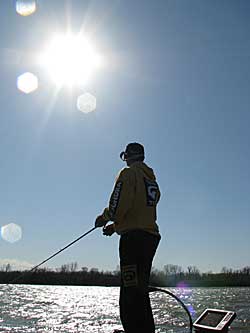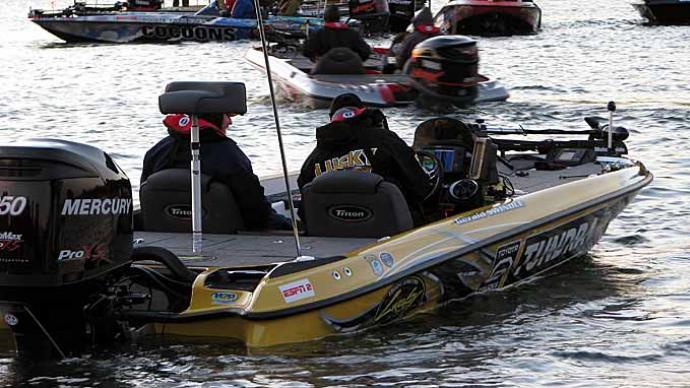
I'm often asked what I do when all else fails. When what you have been doing stops working. When a cold front hits. When the fish shut down. When just nothing is working out.
Well, I have created a box, especially for these situations. This box has bailed me out so many times. It's unbelievable! It has salvaged many tournaments for me and has enabled me to make a check or receive those critical tournament points.
In this Plano 3600 box, labeled "panic box," I have four types of baits. Incidentally, these baits are lures, which I used early in my fishing history when I fished more just to catch fish rather than to catch bass specifically.
The first bait you'll find is my favorite "hard times" bait in my panic box. It's the Mann's 4 inches Draggin Finesse Worm. This is probably the most versatile plastic worm ever designed! This small, needle tail-type worm can be fished in many ways, but I use it in conjunction with a split shot when times are tough.
The small split shot sizes 3 to 7 (approximately 1/16oz. to 1/4oz.) let me use different presentation techniques depending on the conditions. I can use the split shot 8 to 24 inches above Texas rigged worm or place the shot above the knot for more in-and-out cover presentations. Or I can even rig the worm drop-shot style and put the split shot on the bottom of the line.
The action of this bait is incredible. The best example I can give is even if you hold the bait between your fingers and then try and keep completely still, you'll see the tail of this bait shaking and quivering. It's pretty awesome!
I keep it simple as far as colors and try to carry the basics. I like Junebug, kudzu, lavender shad, and chartreuse pumpkinseed. The more natural colors shine in clear water.
Split-shotting the Draggin Worm most often bails me out when I have been catching them on bottom-type baits like larger Carolina rigged plastics, Stone Jigs, or other larger Texas-rigged plastics.
The second bait in my panic box is probably the most basic plastic lure ever designed. It's the grub. In these "hard times" situations, I use the small 3-inch model in two tail types. The action or curl tail model (Mann's Manipulator) and the straight tail model (Mann's Sting Ray).
I use Mann's baits with either an exposed lead head jig or a V-wire guard-type jig head in sizes from 1/16- to ¼-ounce. The conditions dictate which tail type I will choose. Generally, I like the Sting Ray in colder water, and in warmer water, I like the curled tail.
These panic baits bail me out when I had been catching them crankbaiting, or swimming a larger Stone Jig, or when I had been slow-rolling a spinnerbait.
I like three primary colors depending on the forage. White and pearl grubs for when they're feeding on shad or minnows, chartreuse or avocado colors when they're feeding on perch or bluegill, and green pumpkin or amber when they're feeding on crawfish.
The third type of bait in my panic box probably gets the most laughs out of the four. It's the good old in-line spinner. I've used these baits since my trout fishing days as a kid. They are a better baitfish imitator than most lures and will catch everything that swims, INCLUDING BASS! They shine for me if I have been catching them burning spinnerbaits or if they stop hitting topwater lures. They are also really crucial when the smallmouth won't hit anything else.
I like several models of spinners, and I try and base my selection just as I would when picking a spinnerbait. I like to carry spinners with silver, gold, and colored blades (chartreuse and white). I also like to carry some with a willow-type of the blade and some with an Indiana type of blade. I also like to add a split ring to the top of the treble hook if possible.
OK, I know what you're thinking; what about line twist? Well, that is an inherent problem with this type of bait. All I do is if I've used an inline all day, I'll change my line that night. Simple as that.
The last lure you'll find in my panic box is the good old hair jig, which I usually use in conjunction with some Uncle Josh Pork as a trailer. This bait bails me out when the water temp gets cold. In the winter period, if I have been catching them suitable on a Stone Jig or a jigging spoon and they stop biting, they will usually hit this little jig.
I use three primary colors in sizes from 1/16- to ¼-ounce. I like brown, black, and gray or white hair jigs. I also carry them in different types of hair material, but I favor deer hair. I usually match a similar colored piece of Uncle Josh 101 Spinfrog as a trailer.
The baits and techniques we have just talked about naturally cater to using lighter lines and slowing down a little. When conditions get tough and the fish stop biting, finesse presentations become very effective.
This is when I break out my trusty spinning rods spooled with a lighter line. I usually opt for a spinning rod in a 6'6" or 6'3" size with a medium- to medium-light action. I couple this with a spinning reel in the 2500 or 2000 size.
I most often scale down to 6- to 10-pound test lines for line
The four baits I carry in my panic box can save your day when the pressure is on. And they can be put in a small box and stored for an emergency.
You never want to get skunked, whether a tournament angler or a recreational fisherman. These baits will help you put some fish in the boat!




